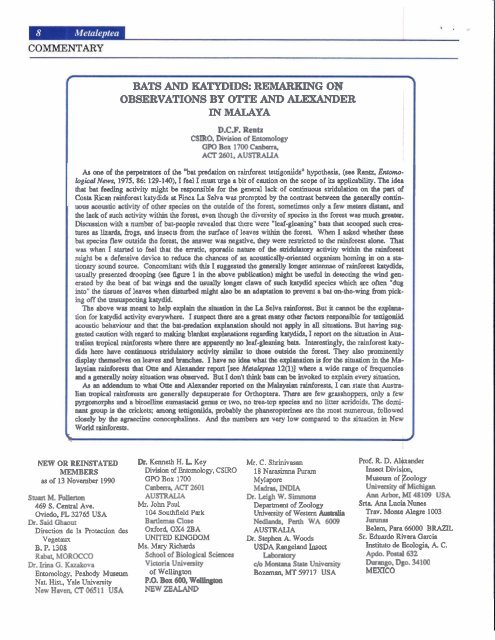met_12_2.pdf
met_12_2.pdf
met_12_2.pdf
You also want an ePaper? Increase the reach of your titles
YUMPU automatically turns print PDFs into web optimized ePapers that Google loves.
BATS AND KATYDIDS: REMARgING ON<br />
OBSERVATIONS BY OTTE AND ALEXANDER<br />
IN MALAYA<br />
D.C.F. Rentz<br />
CSIRO. Division of Entomology<br />
GPO Box 1700 CwbaTa,<br />
ACT 2601, AUSTRALIA<br />
As one of the pnpcumon of the 'bat pd&m on rainforest teuigdds" hyporhepis. (see Renu, Enlomological<br />
N w 1975.86: <strong>12</strong>9-140). I feel I must lqe a bit of caution on the scope of its applicability. The idea<br />
thu bat feeding activity might be responsible for the genersl lack of mtinuous stridulation on the part of<br />
Costa Rican rainforest katydids at Finca La Selva was prompted by the conuast between the genaally fontin-<br />
, wus acoustic activity of other species on the outside of the forest, somelimes only a few maus d h and<br />
I the lack of such activity within the forest, even though the diversity of species in the forest was much greater.<br />
Discassion with a number of bat-pople revealed that there were "leaf-gleaning" bas that swopcd such marcnes<br />
as lizads. frogs. and insects from the surface of leaves within the forest. When I asked whether thew<br />
bat species flew outside the forest, the answer was negative, they were mtricted to the rainforest alone. That<br />
was when I started to feel that the erratic, spdic natlnc of the suidul.tory activity within the r.infncst<br />
might be a defensive device to redm the dunces of an acousticallyolientd orgMism homing in on a stationary<br />
sound source. Conwmitsnt with this I suggested the gawdly bngcr mte.nnae of rainforest katydids,<br />
usually presented Qoopi (see figure 1 in he above publidon) might bc useful in dstecting the wind gmmated<br />
by the beat of bat wings and the ueudly bnga claws of such katydid species which are often "dug<br />
into" the tissues of leaves when disturbed might llso be an ldilptltion to prcvent a bat on-the-wing from picking<br />
off the unsuspecting katydid.<br />
The above was meant to help explain the sinmion in the La Selva ninforest. But it cannot be the exphtion<br />
for katydid activity wsywh. I suspect thae are a gat many other facm resprmsible for teaigoniid<br />
acoustic behmio~w and that the bat-pdah rxpbnuion should not qply in all situations. But having nrggested<br />
caution with regard to mrlring blanket explrrmh regarding katydids, I report on the situation in Auualirm<br />
wpid rainforests w h there ae qpmtly m luf-gkaning bats. Interestingly, the rainforest katydids<br />
here have umtinuous suiduhbny activity similar to thws outside the forest. They also pmhently<br />
display thansclves on leaves and hancher. I have no iden what the explautim is for the situation in the Malaysian<br />
rainforests that Om and Alnnda re+ [see Mua&pfm <strong>12</strong>(1)] when a wide range of frequencies<br />
and a gawdly noisy situstion was obssved. But I don't think bats can be invoked to explain every situation.<br />
As n ddmdum to what Otte and Alcxmdsr rqmtd on the Malaysian rainforests. I can state that Aus-alian<br />
uopical rainforests are generally depaupcrate for Orthoptua. Thsre ua few grasshoppers, only a few<br />
pyrgomqh md a birdline cmnasbzid genus or two. no -top species and no litter acridoids. The dominuu<br />
group is the wick* among teuigoniidh pohbly the phnamptwines are the most numemu, followed<br />
closely by the agasciim mwoephalinss. And the numbers pn vuy low compared to the situation in New<br />
Wodd nsnforcsts.<br />
5<br />
NEW OR REINSTATED h & H . Key Mr. C. Shinivasw Rof. R. D. Alb&<br />
MEMBERS Divkm of Patmnobgy, CSIRO 18 NLLT- Rum Insea Divisioo.<br />
as of 13 November 1990 GW Box 1700 MY~~PO= Museum of f!aology<br />
Cwbma, ACT 2601 Madras. INDIA University of Michigan<br />
Stum M. hrllaton AUSlRALIA Dr. Leigh W. Simmm Ann Arb, MI 48109 USA<br />
469 S. Central Avs. Mr. John Paul Depmma~t of Zoology Srta Ana LucL Nunw<br />
Oviedo - . -. . FL . - 32765 . - . USA - -. . 104 Southtield Park mv&ty of wesfan Trav. Monte Alep 1003<br />
Dr. Said Ghaout Banlernas Close ~edh&, Petth WA 6009 Jutunaa<br />
Dhrction de la Rotection des Oxford 0x4 2BA AUSTRALU Belan, Para 66000 BRAZE<br />
Vegetaux UNITED KINGDOM Dr. Stephen A. Woods Sr. Eduardo Riven Garcia<br />
R -. . I, . l?nn .*""<br />
Ms. Maw Rich& USDA . - -. Rannehd . -- Jnsect Institute de @ivlogio A. C.<br />
Rabat, MOROCCO ~&mi of Biological Scinres Gp- Apdo. Pod 632<br />
Dr. Irina G. Kazakova Victoria University do Monm State University Durango. Dgo. 34100<br />
Entomology. Peabody M u m of Wcwm Boumn. MT 59717 USA MEXICO<br />
Nat Hist., Yale University P.O. Box 600. Wellington<br />
New Hma CC 06511 USA NEW ZEALAND





